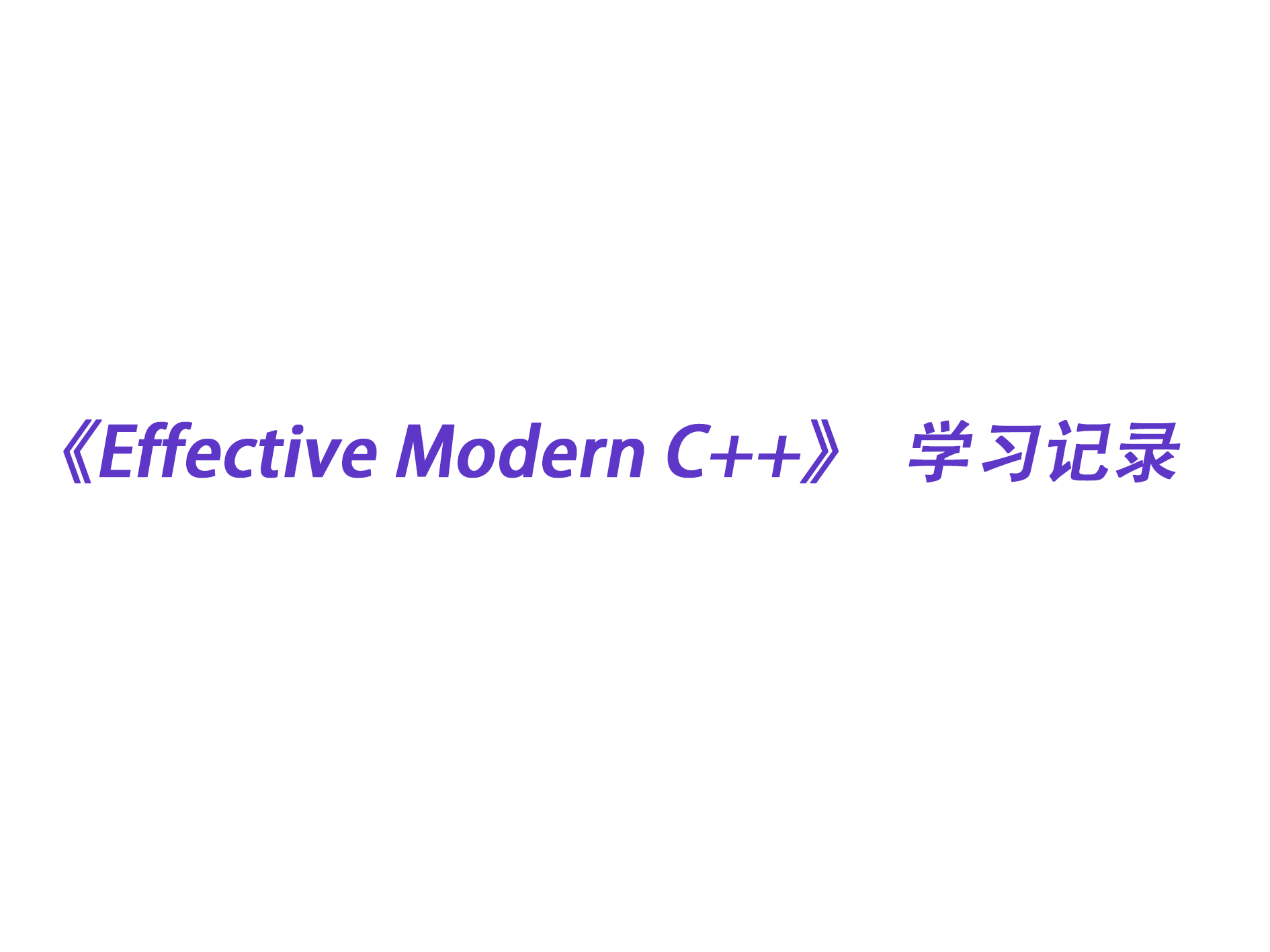1.1 特性一:可以在任何地方初始化
非静态成员变量可以用花括号初始化
1
2
3
4
5
6
7
8
| class Widget()
{
private:
int x{ 0 };
int y = 0;
int z(0);
}
|
对于不可拷贝的对象进行初始化,也可以用花括号初始化(原子对象不可拷贝)
1
2
3
4
| std::atomic<int> ai1{ 0 };
std::atomic<int> ai2(0);
std::atomic<int> ai3 = 0;
|
1.2 特性二:不允许内置类型间隐式的变窄转换
1
2
3
4
| double x, y, z;
int sum1{ x + y + z };
int sum2(x + y + z);
int sum3 = x + y + z;
|
1.3 特性三:防止默认构造函数被混淆为函数声明
1
2
3
4
5
6
|
Widget w1();
Widget w2{};
|
1.4 特性四:花括号返回类型为std::initializer_list导致构造函数被劫持
情况一:
1
2
3
4
5
6
7
8
9
10
11
12
| class Widget
{
public:
Widget(int i, bool b);
Widget(int i, double d);
Widget(std::initializer_list<bool> il);
}
Widget w{10, 5.0};
|
情况二:
1
2
3
4
5
6
7
8
9
10
| class Widget
{
public:
Widget(int i, bool b);
Widget(int i, double d);
Widget(std::initializer_list<string> il);
}
Widget w{10, 5.0};
|
情况三:
1
2
3
4
5
6
7
8
9
| class Widget
{
public:
Widget(int i, bool b);
Widget(int i, double d);
Widget (std::initializer_list<long, double> il);
}
Widget w{10, true};
|
情况四:
1
2
3
4
5
6
7
8
9
10
11
12
13
14
| class Widget
{
public:
Widget();
Widget(std::initialr_list<int> il);
}
Widget w1{};
Widget w2{{}};
Widget w3({});
|
1.5 特性五:某些类库中小括号和花括号的初始化差异
1
2
| std::vector<int> v1(10, 20);
std::vector<int> v2{10, 20};
|
2 nullptr
使用场景:
例1: nullptr在函数重载时的好处
1
2
3
4
5
6
7
8
9
10
11
12
13
14
15
16
17
18
19
20
21
22
23
24
25
26
| #include <iostream>
using namespace std;
void f(int)
{
cout << "exec int" << endl;
}
void f(bool)
{
cout << "exec bool" << endl;
}
void f(void*)
{
cout << "exec void*" << endl;
}
int main()
{
f(0);
f(nullptr);
return 0;
}
|
例2: nullptr表意明确
1
2
3
4
5
6
7
8
| auto result = findRecord();
if (result == 0) {}
if (result == nullptr) {}
|
例3: 在模板推导时避免NULL和0被推导为整型的错误
1
2
3
4
5
6
7
8
9
10
11
12
13
14
15
16
17
18
19
20
| int f1(std::shared_ptr<Widget> spw);
int f2(std::unique_ptr<Widget> upw);
bool f3(Widget* pw);
template<typename FuncType, typename PtrType>
decltype(auto) callFun(FuncType func, PtrType ptr)
{
return func(ptr);
}
auto result1 = f1(0);
auto result2 = f2(NULL);
auto result3 = f3(nullptr);
auto result11 = callFun(f1, 0);
auto result22 = callFun(f2, NULL);
auto result33 = callFun(f3, nullptr);
|
3 别名声明alias declaration
3.1 基本用法:和typedef一样
假如想定义一个std::unique_ptr<std::unordered_map<std::string>, <std::string>>类型的对象,每次都要写一遍太麻烦了。
解决办法如下:
1
2
3
4
5
6
7
8
|
typedef std::unique_ptr<std::unordered_map<std::string>, <std::string>> UPtrMapSS;
using UPtrMapSS = std::unique_ptr<std::unordered_map<std::string>, <std::string>>;
UPtrMapSS x;
std::unique_ptr<std::unordered_map<std::string>, <std::string>> x;
|
3.2 对比typedef的优势
- 在某些情况语义更加明确
1
2
3
|
typedef void (*FP)(int, const std::string&);
using FP = void (*)(int, const std::string&);
|
- 别名声明可以被模板化(别名模板alias templates),但typedef不能
要想使MyAllocList<T> lt等价于std::list<T, MyAlloc<T>> lt,别名声明可以直接这样使用:
1
2
3
4
5
| template <typename T>
using MyAllocList = std::list<T, MyAlloc<T>>;
MyAllocList<int> li;
|
而typedef要想用MyAllocList<T>表示需要模板的std::list<T, MyAlloc<T>>,必须将其包装在一个结构体中,并且调用也更加麻烦
1
2
3
4
5
6
7
8
| template<typename T>
struct MyAllocList
{
typedef std::list<T, MyAlloc<T>> type;
};
MyAllocList<int>::type li;
|
在类模板等场景使用时,由于MyAllocList<T>::type是一个数据类型,且依赖模板参数T,所以是一个依赖数据类型,还需要在前面加typename,更加麻烦了。
而使用using时,编译器知道MyAllocList是一个别名模板,所以知道它一定是一个类型,所以MyAllocList<T>就是一个非依赖类型。
1
2
3
4
5
6
7
8
9
10
11
12
13
14
15
16
17
18
19
20
21
22
23
24
25
26
27
|
template <typename T>
using MyAllocList = std::list<T, MyAlloc<T>>;
template<typename T>
struct MyAllocList
{
typedef std::list<T, MyAlloc<T>> type;
};
template<typename T>
class Widget
{
private:
typename MyAllocList<T>::type list;
};
template<typename T>
class Widget
{
private:
MyAllocList<T> list;
};
|
3.3 在C++11中实现C++14中的模板元编程(TMP)
1
2
3
4
5
6
| std::remove_const<T>::type
std::remove_const_t<T>
std::remove_reference<T>::type
std::remove_reference_t<T>
std::add_lvalue_reference<T>::type
std::add_lvalue_reference_t<T>
|
- 通过以下别名声明,在C++11中调用
std::remove_const_t<T>就等价于std::remove_const<T>::type
1
2
3
4
5
6
7
8
| template <class T>
using remove_const_t = typename remove_const<T>::type;
template <class T>
using remove_reference_t = typename remove_reference<T>::type;
template <class T>
using add_lvalue_reference_t = typename add_lvalue_reference<T>::type;
|




